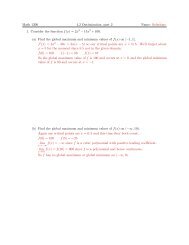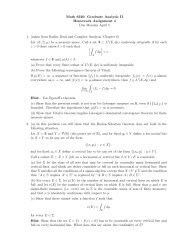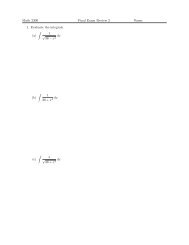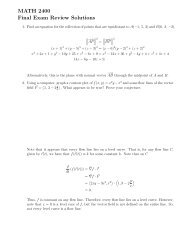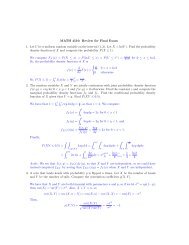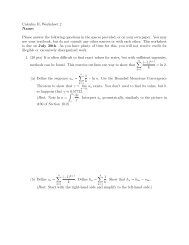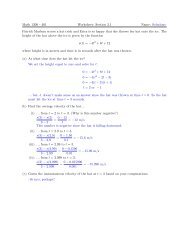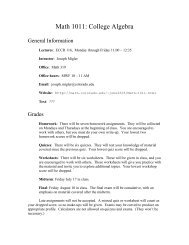Math 1300 - 401 1.1 - 1.4 Practice Problems Name: 1. Consider the ...
Math 1300 - 401 1.1 - 1.4 Practice Problems Name: 1. Consider the ...
Math 1300 - 401 1.1 - 1.4 Practice Problems Name: 1. Consider the ...
Create successful ePaper yourself
Turn your PDF publications into a flip-book with our unique Google optimized e-Paper software.
<strong>Math</strong> <strong>1300</strong> - <strong>401</strong> <strong><strong>1.</strong>1</strong> - <strong><strong>1.</strong>4</strong> <strong>Practice</strong> <strong>Problems</strong> <strong>Name</strong>:<strong>1.</strong> <strong>Consider</strong> <strong>the</strong> functionf(x) = ln(x)(a) What is <strong>the</strong> domain of this function?(0, ∞)(b) What is <strong>the</strong> range?R (all real numbers)(c) Is this function invertible? If so, what is its inverse? (Justify your answer.)Yes, it is invertible since it is a one-to-one function and passes <strong>the</strong> horizontal line test.The inverse is g(x) = e x . To justify this, we’ll compose f and g in both directions andshow that we get x ei<strong>the</strong>r way:f(g(x)) = f(e x ) = ln(e x ) = x ln(e) = x · 1 = xg(f(x)) = g(ln(x)) = e ln(x) = x2. Suppose we define a function f that take names of countries as inputs and gives <strong>the</strong> country’sofficial language as an output. For instance,f(Brazil) = PortugueseExplain why this function is not invertible.This function is not invertible since it is not one-to-one. For instance, <strong>the</strong> official languageof <strong>the</strong> USA is English, and <strong>the</strong> official language of England is also English. So an inversefunction wouldn’t know what country should be an output for <strong>the</strong> input “English”.3. The graph of <strong>the</strong> function y = x 2 is shifted up by 2 and right by 5. Write an expression for<strong>the</strong> new function.y = (x − 5) 2 + 24. Draw and label a set of (x, y)-axes in <strong>the</strong> space below. On <strong>the</strong>m, plot <strong>the</strong> line given by <strong>the</strong>equation6x + 2y = 4What is <strong>the</strong> slope of this line? What is its y-intercept?We solve for y to gety = −3x + 2so this is a line with slope -3 and y-intercept 2.
<strong>Math</strong> <strong>1300</strong> - <strong>401</strong> <strong><strong>1.</strong>1</strong> - <strong><strong>1.</strong>4</strong> <strong>Practice</strong> <strong>Problems</strong> <strong>Name</strong>:5. The population of Logopolis, USA is 20 ma<strong>the</strong>maticians at time t = 0. Write a formula thatmodels <strong>the</strong> population of Logopolis as a function of time if . . .(a) . . . <strong>the</strong> population is increasing at a rate of 10 ma<strong>the</strong>maticians per year.P = 20 + 10t (where t is in years)(b) . . . <strong>the</strong> population is increasing at a rate of 10% per year.P = 20(<strong><strong>1.</strong>1</strong>) t (where t is in years)(c) In case (b), how long will it take for <strong>the</strong> population of Logopolis to double?After <strong>the</strong> doubling time passes, <strong>the</strong> population will be 40 ma<strong>the</strong>maticians. So we set Pequal to 40 and solve for t:40 = 20(<strong><strong>1.</strong>1</strong>) t2 = (<strong><strong>1.</strong>1</strong>) tlog(2) = log((<strong><strong>1.</strong>1</strong>) t )log(2) = t log(<strong><strong>1.</strong>1</strong>)t = log(2)/ log(<strong><strong>1.</strong>1</strong>)t ≈ 7.3 years6. Solve for x:5(3) 7x = 8(3) 5x5(3) 7x = 8(3) 5x(3) 7x(3) 5x = 8 5(3) 7x−5x = 8/5(3) 2x = 8/5log((3) 2x ) = log(8/5)2x log(3) = log(8/5)2x = log(8/5)log(3)x = log(8/5)2 log(3)x ≈ 0.214
<strong>Math</strong> <strong>1300</strong> - <strong>401</strong> <strong><strong>1.</strong>1</strong> - <strong><strong>1.</strong>4</strong> <strong>Practice</strong> <strong>Problems</strong> <strong>Name</strong>:For <strong>the</strong> problems below, you don’t need to simplify.7. If f(x) = 3x 2 + x + 5 and g(x) = e x , <strong>the</strong>nf(g(x)) = 3(e x ) 2 + e x + 5andg(f(x)) = e (3x2 +x+5)8. If h(x) = √ x + x and j(x) = x − 7, <strong>the</strong>nh(j(x)) = √ x − 7 + (x − 7)andj(h(x)) = ( √ x + x) − 7



